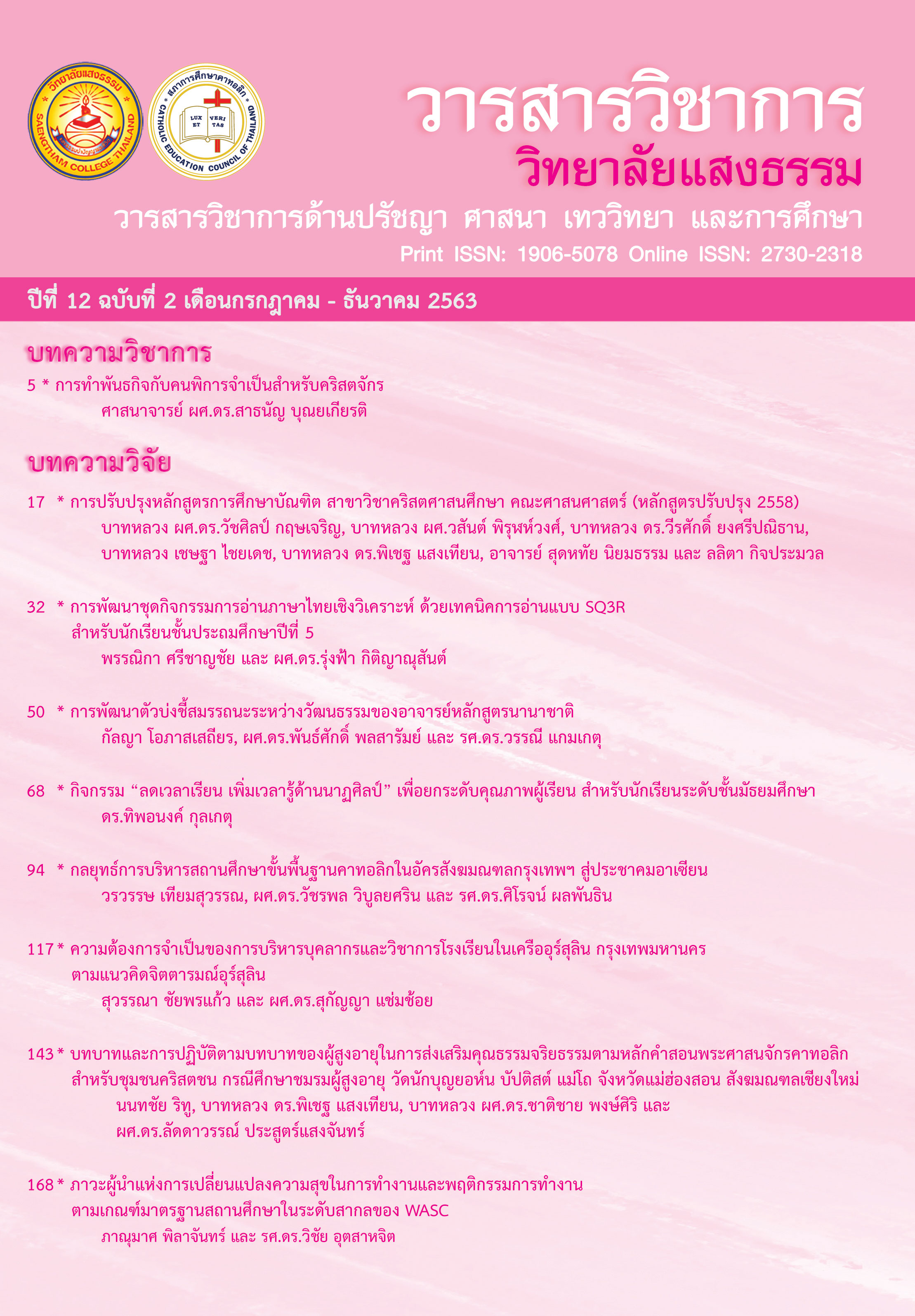กิจกรรม “ลดเวลาเรียน เพิ่มเวลารู้ด้านนาฏศิลป์” เพื่อยกระดับคุณภาพผู้เรียน สำหรับนักเรียน ระดับชั้นมัธยมศึกษา
Main Article Content
บทคัดย่อ
การวิจัยนี้มีวัตถุประสงค์เพื่อ 1) ถอดบทเรียนรูปแบบการจัดกิจกรรม“ลดเวลาเรียน เพิ่มเวลารู้ด้านนาฏศิลป์” เพื่อยกระดับคุณภาพผู้เรียน สำหรับนักเรียนระดับมัธยมศึกษา 2) พัฒนากิจกรรม“ลดเวลาเรียน เพิ่มเวลารู้ด้านนาฏศิลป์” เพื่อยกระดับคุณภาพผู้เรียน สำหรับนักเรียนระดับมัธยมศึกษา 3) ทดลองใช้กิจกรรม“ลดเวลาเรียน เพิ่มเวลารู้ด้านนาฏศิลป์” เพื่อยกระดับคุณภาพผู้เรียน สำหรับนักเรียนระดับมัธยมศึกษา 4) ประเมินผลกิจกรรม“ลดเวลาเรียน เพิ่มเวลารู้ด้านนาฏศิลป์” เพื่อยกระดับคุณภาพผู้เรียน สำหรับนักเรียนระดับมัธยมศึกษา ใช้ระเบียบวิธีวิจัยแบบการวิจัยและพัฒนา (Research & Development) กลุ่มเป้าหมายในการวิจัย คือ นักเรียนระดับชั้น มัธยมศึกษา ดำเนินการวิจัยในภาคเรียนที่ 1 ปีการศึกษา 2560 เครื่องมือที่ใช้ในการวิจัย ได้แก่ แบบทดสอบความรู้ด้านนาฏศิลป์ไทย แบบประเมินผลงานนาฏศิลป์สร้างสรรค์ แบบประเมินความพึงพอใจที่มีต่อกิจกรรม วิเคราะห์ข้อมูลโดยใช้ค่าร้อยละ ค่าเฉลี่ย ค่าส่วนเบี่ยงเบนมาตรฐาน และการวิเคราะห์เนื้อหา ผลการวิจัยพบว่า 1. ผลการพัฒนากิจกรรม “ลดเวลาเรียน เพิ่มเวลารู้ด้านนาฏศิลป์” เพื่อยกระดับคุณภาพผู้เรียน สำหรับนักเรียนระดับชั้นมัธยมศึกษา มีองค์ประกอบดังนี้ หลักการ เป้าหมาย แนวการจัดกิจกรรม จุดประสงค์การเรียนรู้ โครงสร้างการจัดกิจกรรม สื่อ/แหล่งเรียนรู้ประกอบกิจกรรม การวัดและประเมินผล และคำชี้แจงในหน่วยการเรียนรู้ 2. ผลการทดลองใช้กิจกรรม “ลดเวลาเรียน เพิ่มเวลารู้ด้านนาฏศิลป์” เพื่อยกระดับคุณภาพผู้เรียน สำหรับนักเรียนระดับชั้นมัธยมศึกษา 2.1 ด้านความรู้ มีคะแนนเฉลี่ยเท่ากับ 17.60 ส่วนเบี่ยงเบนมาตรฐานเท่ากับ 0.78 2.2 ด้านความสามารถในการปฏิบัตินาฏศิลป์ไทย ในภาพรวมอยู่ในระดับดีมาก มีคะแนนเฉลี่ยเท่ากับ 82.50 ส่วนเบี่ยงเบนมาตรฐานเท่ากับ 0.17 2.3 ด้านความพึงพอใจ โดยภาพรวมอยู่ในระดับดีมากที่สุด ค่าเฉลี่ยเท่ากับ 4.81 ส่วนเบี่ยงเบนมาตรฐานเท่ากับ 0.44 3. ประเมินผลกิจกรรม“ลดเวลาเรียน เพิ่มเวลารู้ด้านนาฏศิลป์” เพื่อยกระดับคุณภาพผู้เรียน สำหรับนักเรียนระดับชั้นมัธยมศึกษา ตามกรอบมาตรฐานการประเมิน 4 ด้าน พบว่า มีประสิทธิภาพอยู่ในระดับมากทุกด้าน ค่าเฉลี่ยเท่ากับ 4.29 ส่วนเบี่ยงเบนมาตรฐานเท่ากับ 0.47
Article Details
- บทความที่ได้รับการตีพิมพ์ในวารสารวิชาการ วิทยาลัยแสงธรรม ถือเป็นกรรมสิทธิ์ของวิทยาลัยแสงธรรม ห้ามนำข้อความทั้งหมดไปตีพิมพ์ซ้ำ ยกเว้นได้รับอนุญาตจากวิทยาลัยแสงธรรม
- เนื้อหาและข้อคิดเห็นใดๆ ที่ตีพิมพ์ในวารสารวิชาการ วิทยาลัยแสงธรรม ถือเป็นความรับผิดชอบของผู้เขียนเท่านั้น
เอกสารอ้างอิง
ปกครอง บัววิรัตน์เลิศ พัชรีวรรณ กิจมี. (2559). ความพึงพอใจของผู้เรียนที่มีต่อโครงการลดเวลาเรียนเพิ่มเวลารู้ในโรงเรียนระดับประถมศึกษา. (งานวิจัยหลักสูตรมหาบัณฑิต). สาขาการบริหารการศึกษา คณะศึกษาศาสตร์, มหาวิทยาลัยฟาร์อีสเทอร์น.
ชัยภัทร วทัญญู. (2558). ผลการพัฒนาทักษะของชีวิตของนักเรียนชั้นประถมศึกษาปีที่ 5 โรงเรียนอนุบาลบ้านหมอ (พัฒนราษฏร์) โดยใช้กิจกรรมลดเวลาเรียนเพิ่มเวลารู้ เรื่องทำกินได้ ทำขายดี. สระบุรี: โรงเรียนอนุบาลบ้านหมอ.
จุฑามาศ สุธาพจน์ ธีระดา ภิญโญ. (2559). แนวทางการบริหารกิจกรรมการเรียนรู้ตามนโยบาย "ลดเวลาเรียน เพิ่มเวลารู้" ของสถานศึกษาขั้นพื้นฐาน สังกัดสำนักงาน เขตพื้นที่การศึกษาประถมศึกษานนทบุรี เขต 2. (งานวิจัยหลักสูตรมหาบัณฑิต). สาขาวิชาบริหารการศึกษา, มหาวิทยาลัยราชภัฏสวนสุนันทา.
สุกัญญา งามบรรจง. (2559). การพัฒนารูปแบบการจัดกระบวนการเรียนรู้เพื่อเสริมสร้างทักษะในศตวรรษที่ 21 ผ่านกิจกรรมลดเวลาเรียน เพิ่มเวลารู้ ของสำนักงานคณะกรรมการการศึกษาขั้นพื้นฐาน. สำนักงานคณะกรรมการการศึกษาขั้นพื้นฐาน.
ศลิษา ชุ่มวารี. (2557). การพัฒนาความรู้ความเข้าใจอย่างถาวรด้านนาฏศิลป์เพื่อนำไปประยุกต์ใช้ในชีวิตประจำวัน โดยการใช้ชุดการสอนเรื่องนาฏยศัพท์และภาษาท่านาฏศิลป์ไทย สำหรับนักเรียนชั้นประถมศึกษาปีที่ 6. โรงเรียนปรินส์รอยแยลส์วิทยาลัย.
พัชนีพงศ์ คล่องนาวา. (2553). การพัฒนาความสามารถในการรำวงมาตรฐาน ของนักเรียนชั้นประถมศึกษาปีที่ 5 ด้วยการจัดการเรียนรู้โดยใช้กิจกรรมกลุ่มสัมพันธ์. มหาวิทยาลัยศิลปากร.
Fosnot Ganesh. (1996). Competency Based HRM. Tata McGraw-Hill Publishing Company Limited: New Delhi.
Papert, Lyle M.; & Spencer, M. Signe. (1991). Competency at work. New York: Willey.
Vygotsky. (1962). “Emotional Intelligence and Core Competencies” Journal of Extension. December 1999, 37(6): 20-29.
Stufflebeam,D.,Shinkfield, A., (2007). Evaluation theory, model, & application. San Francisco: Jossey – Bass.
Oliva, P.F. (1992). Developing the Curriculum. (3 rd ed). New York: Harper Collins.


